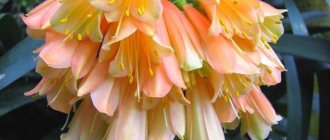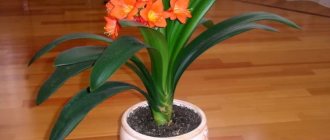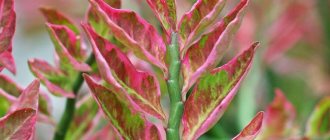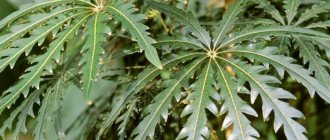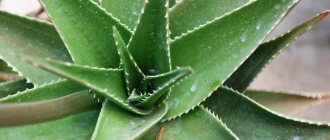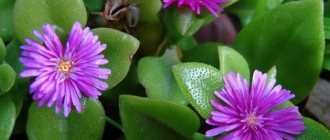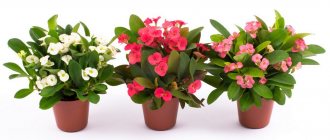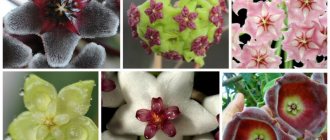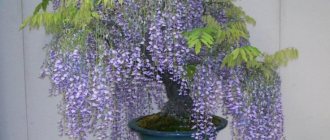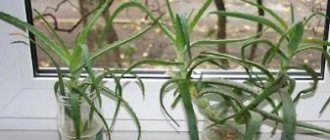Clivia
The beautiful indoor flower Clivia (lat. Clivia) has long taken its place in the hearts of home flower lovers.
The plant is unpretentious in care. Its dark green leaves fit perfectly into the interior decor, and its unique inflorescences will not leave anyone indifferent. Clivia miniata
There are 5 types of clivia in total. The most popular species grown at home is Clivia miniata. Its other names: orange clivia (matte red, red lead, red lead), or kaffir (Cape).
A huge number of clivia varieties have been developed that have a rich range of colors. The plant comes in almost all shades of orange, red and yellow.
Varieties
At home, three types of clivia are most often found: cinnabar, gardena and beautiful. Nevertheless, the flower is so good that new hybrid varieties are still being bred all over the world.
Table: distinctive features of various types
| Clivia variety | Peduncle height | Characteristics of flowers | Flowering time |
| Clivia cinnabar, or minium-orange (Clívia miniata) | 40–50 cm | Inflorescence in the form of a rosette with 10–20 flowers | February-May, but sometimes blooms at other times of the year |
| Clívia gardenii | 45–50 cm | 10–16 flowers | Second half of winter |
| Clivia beautiful, or noble (Clívia nobilis) | 30–50 cm | Inflorescence with 40–60 flowers | Second half of winter |
Clivia cinnabar turned out to be a very flexible plant, and on its basis more than a dozen new varieties with flowers of various colors were bred.
Photo gallery: Clivia cinnabar, also known as miniata, and other species
Clivia cinnabar blooms with bright orange-red flowers
A distinctive feature of Clivia Gardena flowers is their tubular shape and green tips.
Clivia Nakamura Red has bright red flowers.
Clivia citrina is a variety of Clivia miniata with creamy yellow flowers.
Clivia yellow is one of the hybrids bred on the basis of Clivia cinnabar
Clivia nobilis has drooping tubular flowers of red color with a white tip.
Caring for clivia at home
This section describes in detail how to care for clivia cinnabar at home.
Temperature . When caring for clivia, the temperature should vary depending on the time of year. In summer the recommended temperature is from 20 to 25 °C, in winter - no higher than 15 °C.
Lighting . Indoor clivia likes fairly sunny places, but can get burned from direct sunlight. With a lack of sun, flowering will not be complete, the flowers will become small and the flower stalks will be short.
Watering clivia . Clivia should be watered sparingly at home. A decrease in temperature affects the demand for moisture. It is preferable to use soft, boiled or settled water. By the way, you need to pay attention to the water temperature; if there is no flowering for too long, it should be warm. When flower stalks 10 cm tall appear, you need to water more often.
Air humidity does not play a role when growing, so it makes no sense to spray the leaves for the purpose of moisturizing.
Feeding . In the spring and summer, fertilizers can be applied every half month. These can be either complex fertilizers or alternating organic and mineral ones. Feeding should be stopped when clivia enters a dormant period, as this will exhaust its strength and the flower may die.
Soil and drainage . Growing works best in loose, slightly acidic soil containing peat, humus (25% each) and turf soil (50% in composition). Drainage for cultivation is a must.
Clivia after flowering What to do when it has faded?
The period after flowering is conventionally divided into two halves. The first occurs in the summer, when clivia grows green mass and enjoys natural warmth and light. The second half is a dormant period when the flower is taken to a cool place. Most often, the glazed loggia of a city apartment plays this role. It would be useful to remind you that at temperatures below +12 °C clivia dies.
The length of rest for clivia directly depends on its age. A couple of months (from September to November) are enough for young plants to gain strength for flowering. Starting from the age of five, the plant is given a full autumn-winter rest from September to February. And only the appearance of a peduncle brings the aged clivia out of its sleepy state.
Clivia transplant
This flower tolerates transplantation quite painfully. Damaged roots will rot after replanting. Therefore, it is often better to only transship the plant.
Transshipment of clivia should be done after flowering, but not more often than once every two years. For young clivia, you can do it once a year. It is also recommended to simply update the top 5 cm of the substrate once a year.
It is definitely worth remembering that clivia loves a cramped pot. And once again she shouldn’t be bothered with transplants. And if you have already started replanting, then you need to do this very carefully so as not to damage the roots of the plant.
Watering
Clivia should be watered sparingly. Stagnation of water is unacceptable. Before the next watering, the top layer of soil in the pot should dry well.
Water for irrigation should be settled and warm . 10-15 minutes after the procedure, the water should be poured out of the pan.
In the fall, after clivia blooms, the frequency of watering must be gradually reduced , thus preparing the plant for the dormant period. At the end of autumn - beginning of winter, clivia does not need watering.
When the flower arrow appears, watering must be resumed. However, at first it should be meager. When buds appear, the regularity and amount of moisturizing must be gradually increased to the usual norm.
Reproduction
The plant is propagated at home by seeds or suckers.
Clivia seeds are sown to a depth of 1 cm in a mixture of sand and peat, covered with film or glass to retain heat. After about 40 days, shoots appear from the seeds, and after another 60 days they can be replanted. Interestingly, young plants love the same small pots.
The vegetative method of propagating clivia involves dividing the bush during transplantation. It should be separated carefully, because the root system is very delicate. Children must have at least 4 leaves. Interestingly, this member of the amaryllis family lacks the usual bulb. It is replaced by leaves that wrap around each other and form a fairly strong stem.
Why do clivia leaves turn yellow?
In order to understand why clivia leaves turn yellow, you need to determine whether this is the result of natural processes or caused by care errors. If the lower leaves gradually turn yellow, and new ones grow in return, most likely, a normal physiological process of old leaves dying off and replacing them with young ones occurs, which takes quite a lot of time and should not cause concern to the gardener.
Worse, if a change in color is observed on all leaves, this usually signals unfavorable conditions for the plant that need to be eliminated to prevent its death. Clivia leaves turn yellow when there is not enough water, or when watering is excessive. In the latter case, the roots rot, and to save the flower you will have to dig it up, remove the damaged roots, not forgetting to disinfect the cuts, and then replant it in fresh soil and a new pot. By yellowing the leaves, a flower can respond to a lack of nutrition caused by a lack of regular feeding, depletion due to fruit set and seed ripening, replanting, and even a change in location in the room.
Diseases and problems with flowers
This beautiful plant can get sick from scale insects and mealybugs. Follow the links to see photos of damaged plants and pests, and how to deal with them.
Why doesn't clivia bloom? If there is no flowering at all, then you need to check whether the air temperature is high, whether there is enough light, and whether the clivia is given a rest period in full volume.
Why do clivia leaves become covered with white spots? If white spots appear on the leaves, it means the flower has received a sunburn.
Why did the tips of the leaves turn brown? The tips of the leaves have turned brown, which means that the soil is too moist.
Why do clivia leaves turn yellow? If the leaves turn yellow in small quantities and are periodically renewed, then everything is in order with the flower. This is a normal process. But if most of the foliage has turned yellow, then this is the first alarm signal. There may be several reasons. Leaves may turn yellow if watered too little or too much. If the second is true, then the clivia must be immediately removed from the pot and checked for root rot. If rotting occurs, bad roots are carefully removed and the cut sites are disinfected. After this, the clivia must be transplanted into a new substrate.
Also, the leaves may turn yellow after a change in environmental conditions (for example, the flower was moved to another place in the room). Lack of feeding can also lead to yellowing of the foliage.
Benefits and harms
Clivia is a very cheerful plant. Its bright flowers and luscious leaves create a wonderful mood and a sense of harmony, and it is also believed that the presence of clivia in the house normalizes the circulatory system.
The roots and leaves of Clivia cinnabar are actively used in pharmacology , and indigenous people of Africa use clivia for fever and as a pain reliever for poisonous snake bites.
IMPORTANT! It should be remembered that parts of the plant are very toxic! Replant the plant only with gloves on! Do not try to experiment with clivia treatment, it is very dangerous!
However, if you follow the simplest precautions and with proper care, clivia will delight you with beautiful flowers and fresh, bright leaves for a long time.
Clivia blooming
It is believed that clivia received its sonorous name from a noble lady, the Duchess of Northumberland, Charlotte Clive (“Clive”). It was from this eminent Englishwoman that the flower first bloomed; previously in England, the newly brought strange plant was considered not to bloom. Clivias are a whole genus of herbaceous perennial plants of the amaryllis family.
In literature, the African woman is often called Cape, in connection with her habitat. It is the Cape floristic kingdom that is home to many deciduous plants. This is the Southeast part of Africa, where the flower is especially common in natural conditions. In our country, clivia was named meerkotsvetna for the bright fiery color of its flowers. In nature, it ranges from red to carrot-colored. As you know, red lead is an orange-red lead paint.
Interestingly, the clivia flower in its natural environment almost always grows in groups. She, like Zamioculcas and Sansevieria, belongs to stemless plants. The leaves of this beauty are fleshy and dense, young leaves have a light green tint, and with age they darken and acquire a dark green color. By about 14 years old, she can grow about 30 leaves, their length and width depending on the type of flower.
Clivia Gardena is the first variety that, thanks to the European military, visited England in the 18th century. It is believed that it appeared in Europe thanks to Major Robert Garden, who served in Natal, an area of the African continent.
K. Gardena
Clivia cinnabar, or miniata, is the most common species in indoor floriculture. The height of the plant is about 60 cm, and the long peduncle produces 10-20 funnel-shaped flowers. By the way, cinnabar is a shade of red. In nature, this plant climbs high into the mountains, choosing places at an altitude of 600-800 m above sea level.
k. cinnabar
k. cinnabar variety
cinnabar varieties
Clivia citrina is a variety of the miniata species that was discovered in the late 18th century. Identical in shape and size, it forms umbrella-shaped inflorescences with flowers of an amazing lemon shade. The fruits of this individual are also yellow in color.
Habitat and appearance of clivia
In nature, clivia, a plant belonging to the Amaryllis family, grows in the foothills and coastal areas of southern Africa. The same family includes hemanthus, hippeastrum and amaryllis, but clivia is significantly different from its counterparts; it does not have a bulb, like other representatives of the Amaryllis family. The flower develops a rhizome, to which leaf blades thickened at the base are attached.
A special feature of clivia is that its sword-shaped leaves of dark green color form a false stem, tightly covering each other. Clivia produces a peduncle on which an umbrella-shaped inflorescence is formed, consisting of several dozen flowers that bloom gradually. Thanks to this, the flowering period of the African beauty lasts quite a long time, three to four weeks.
Keeping clivia in an apartment is not very difficult or troublesome, although the flower is quite capricious during the flowering period. But if you follow a few rules of care and organize the necessary conditions during the dormant period, then clivia will thank you every year with incredibly spectacular flowering in winter - just when there is a lack of bright colors.
In nature, clivia is found in the south of the African continent.
Clivia vs wallota: how to distinguish between plants
Clivia is often confused with wallota, although the plants differ significantly from each other. The main feature of clivia is the absence of a bulb. It has a short, thick rhizome, while the wallot has an elongated bulb with brown scales. Unlike clivia, wallota has narrow, long leaves that grow singly, while clivia has larger leaf blades and are arranged in a fan.
Wallot flowers are quite large and red in color, on average there are 5 of them on one peduncle. The color palette of clivia ranges from yellow to bright red, its flowers are smaller, there are from 10 to 40 pieces on the peduncle. Another feature of clivia that distinguishes it from wallot is its orange juice. If you cut a leaf, orange droplets will appear on the cut.
Wallot has red and rather large flowers, on average there are 5 of them on a peduncle
Flower species diversity
Clivia has been grown as an ornamental plant for interior decoration for a long time, although several species were discovered only in the 21st century:
- The habitat of Clivia beautiful (noble) is the Cape Province of South Africa. The plant is low and compact, reaching 30 cm in height. The leaf blades of Clivia beautiful are wide (up to 6 cm), tubular flowers form an umbrella-shaped inflorescence. The plant has graceful flowers with green tips. Their number reaches 50–60 pieces on one peduncle.
- Clivia cinnabar (Miniata) grows in the Natal province of South Africa. The plant is most often found among lovers of indoor floriculture. The flower reaches 0.5 m in height, has wide fleshy leaves, collected in a fan. The flowers, collected in an umbrella of 10–20 pieces, are orange with a yellow center.
- Clivia Gardena got its name in honor of Robert Gardena, a British army major who discovered it in the South African province of Natal. It mainly grows in mountainous areas. Clivia Gardena differs from other species of this plant in its lighter foliage color and tubular flowers of a light orange hue, while the tips of the petals are colored green.
- A variety of Clivia cinnabar is Citrina. The difference between the plant is the color of the flowers. Citrine has delicate creamy yellow flowers and yellow berries.
- The Clivia cyrtantiflora hybrid was obtained by crossing Clivia Miniata (cinnabar) and noble (beautiful). The plant has numerous narrow, tubular-shaped flowers of a light red hue.
- A large plant, reaching 1.8 m, is powerful or marsh clivia. The plant prefers swampy, damp places, which is why it got its second name.
- Clivia amazing was discovered by botanists quite recently - in 2002 in the north-west of the Republic of South Africa. The plant is light-loving. It tolerates both drought and light frosts well. The leaf blades have a dark burgundy tint at the base, with a white stripe in the middle of the leaf.
- A large plant, reaching one meter in height (some specimens grow up to three meters), Clivia stem grows in the eastern and northern provinces of South Africa. The flower prefers poor rocky soil. Due to its large size, it is grown mainly in greenhouses.
Photo gallery: types of clivia popular in home floriculture
Clivia amazing was discovered quite recently - in 2002
Clivia powerful or swamp is a large plant reaching 1.8 m in height
Clivia cirtantiflora is a hybrid obtained by crossing Clivia nobilis and cinnabar Clivia Citrina has creamy yellow flowers and yellow berries Clivia cinnabar is most often found among lovers of indoor floriculture. The second name of the flower is Miniata
Gardena differs from other types of clivia in its lighter foliage color and yellowish-orange tubular flowers, while the tips of the petals are colored green.
Beautiful Clivia flowers are yellowish-orange or red with green tips.
Rules of care
Comfortable growing conditions require moderate watering, a bright location and a dormant period. The website flowery-blog.ru will tell you how to create ideal conditions for a plant?
Temperature and lighting
Like any flowering plant, clivia loves light! The ideal location for it would be windows in a western or eastern direction. But active sun rays can cause burns! Therefore, a more southern orientation requires mandatory shading during the midday hours. The plant can develop in partial shade, but it will be stunted in growth and, most likely, will not bloom (how to measure the light level).
In summer, the flower adapts well to temperatures up to 25 degrees. With the arrival of autumn, usually in October, when daylight hours decrease, it begins a period of rest and preparation for flowering. At this time, it is better to ensure a temperature of 12-15 degrees. As soon as the clivia produces a peduncle, the temperature is increased. Such activities will help ensure longer and more abundant flowering. In summer, the plant can be taken out onto the balcony; fresh air is good for it!
collection of Ekaterina Malygina
Watering and humidity
Clivia at home does not require high air humidity. But the plant will like periodic spraying! However, you should do this with caution, trying to prevent water from pouring inside the leaf outlet. Like sansevieria, aloe, haworthia and other flowers that have vaginal leaves (tightly covering each other), water, accumulating, can cause rotting. It is useful to periodically wipe the wide leaves with a damp cloth. Foliar feeding - what is it?
The clivia flower easily tolerates drought, but has a negative attitude towards overflow. Therefore, between waterings, the soil in the pot should dry out well. During the dormant period, low air temperatures should be accompanied by minimal watering. If the flower is in a warm room during hibernation, the frequency of watering does not change. 8 questions about watering indoor flowers.
Fertilizers and fertilizers
Clivia responds well to fertilizers! During the period of active growth, the flower must be regularly fed with complex mineral fertilizers. How to choose mineral fertilizer. You can also use organic matter (ash, compost, mullein, sapropel, etc.) as fertilizer. How to use organics for flowers. Clivia blooming needs mandatory feeding once every 10 days; during the dormant period from October until the appearance of the peduncle, no feeding is done.
Important! Quiet period! The plant uses the microelements accumulated over the summer to form a peduncle, and the low temperature coupled with minimal watering reduces the growth rate. From October, when daylight hours are reduced, clivia is placed on a cool windowsill (make sure there are no frosty drafts) with the least amount of light, and watering is reduced. As soon as the peduncle appears, the plant is moved to a bright, warm place, watering is increased and fertilizing is done.
Reproduction and transplantation
The clivia flower does not like to move frequently, so you should determine a permanent place for it. It looks especially impressive next to plants such as nephrolepis. She is also having a hard time with the transplant, for which there must be good reasons. Along with other flowering representatives of the flora - eucharis, hoya, hibiscus, clivia blooms more readily if the pot is the right size for it; in a container that is too spacious, you will have to wait a long time for flowering!
It is better to choose a cylindrical pot for clivia, as the powerful root system develops in depth. Pots that taper towards the bottom are not suitable for it. Types of flower pots.
When planting, do not bury the plant; the entire leaf part should be above the ground. The soil for clivia should be loose and light. This can be a mixture of garden soil with peat and sand in a 2:1:1 ratio. However, any ready-made slightly acidic earth mixture based on core peat will do. The soil may contain tree bark, or charcoal, vermiculite, or perlite. Tips for choosing a substrate.
There are two ways to propagate clivia at home. In adult plants of four and five years of age, daughter shoots appear. When the number of leaves on the children reaches 4-5, they can be separated from the mother plant and planted in separate pots. Young plants, especially after transplantation, need to be watered with great care, as there is a risk of flooding them! All transplant procedures must be carried out after flowering.
Another method is propagation by seeds, which is quite labor-intensive in indoor floriculture. In addition, it is worth remembering that seed ripening takes a lot of energy from the plant, depleting it!
How to trim a clivia flower stalk after flowering? When the plant has finished flowering, trim the ovaries as low as possible (unless you want to wait until the fruits ripen). The remaining stem will dry out over time, then it must be carefully “pulled out” from the leaves. If it's dry enough, it will give in easily!
Growing clivia from seeds
How to get seeds
Usually clivia seeds are purchased at the store. The desire to have their own seed material from a pet pushes flower growers to take the extreme step of getting them themselves. Flower lovers are not deterred by the fact that the full ripening of the fruit takes a lot of energy from the plant and exhausts it. But the planting material turns out to be excellent, immediately ready for planting.
At the beginning, the flowering plant is artificially pollinated using a soft brush. The wait for ripe fruits lasts up to 9 months. Full ripening will occur when the fruit (berry) changes color from green to red, and its hard structure becomes soft. Seeds are planted immediately, without delay. Clivia belongs to the group of plants whose seeds lose their viability every day. For this reason, you should prepare in advance for collecting seeds and hurry up with their subsequent planting.
How to plant clivia seeds:
Clivia from seeds Photo of seedlings
- Fresh seeds are kept in water for 24 hours to swell.
- Mix the soil components in equal proportions and place it in a container. The soil is prepared either two-component, consisting only of perlite with peat, or three-component, representing a mixture of turf soil, sand, and peat.
- The distance between seeds is at least 2 cm, but 5-6 cm is better.
- To create greenhouse conditions, the container is covered with plastic film or glass.
- Every day, ventilate for 10-15 minutes and, if necessary, lightly moisten.
- Picking is carried out immediately after the appearance of the first true leaf. To do this, take small pots, fill them with soil formed from humus, deciduous soil, clay soil, and plant seedlings there.
Slow-growing seedlings often become a source of concern as they appear to be frozen for the first 2 years. Every year, a young clivia, together with a lump of earth, is moved into a wider pot. A plant obtained from a seed is suitable for flowering only after 4-6 years of life.
Video about growing clivia from seeds:
Problems growing?
The clivia flower is easy to care for, but gardeners often encounter difficulties. What are the reasons for the whims of an African woman?
- Why doesn't clivia bloom...
This is the most common cause for concern! It is worth remembering that young plants bloom only for 2-3 years. If clivia has never bloomed before, give it a forced rest period from October to March-April. The day before, be sure to feed the flower with phosphorus-potassium fertilizers (within normal limits!), they stimulate the formation of buds. In turn, an excess of nitrogen fertilizers is manifested by rapid growth of foliage, while the plant looks healthy, but does not bloom. Read above about organizing the rest period.
- Why does clivia have a short peduncle...
Sometimes the peduncle with buds “stays” halfway, as if stuck between the leaves. This may be a consequence of a lack of microelements, especially potassium and phosphorus, which promote flowering. On the eve of the dormant period, the plant must be fed with potassium-phosphorus fertilizers.
The reason may also be too low a temperature during the period of peduncle formation. Perhaps there was a draft, or the temperature dropped below +12 degrees, this could slow down the development of the flower shoot. As soon as the arrow appears, you must immediately move the flower to a warm place, water it abundantly and fertilize it.
- If the tips of the clivia leaves darken...
This problem occurs when there is excess moisture, which the flower does not like! Thus, clivia signals overflow, or problems with the roots. If the leaf simultaneously becomes soft, this is a clear sign of waterlogging! Regulating watering is not enough; often it is necessary to inspect the underground part of the plant. After all, the fleshy white roots easily rot if they are in constantly damp soil. At the same time, they turn from white to dark and wrinkle. All these parts need to be removed, sprinkled with crushed coal on the sections, and the flower should be planted in new soil.
A similar situation occurs with hypothermia, or frostbite. In the latter case, the leaves droop and become lifeless, like rags. The affected foliage must be removed; it will not recover.
- If the leaves of a clivia flower turn yellow...
Bloom
At the end of winter or at the beginning of spring, an arrow-peduncle appears. When it becomes at least 10-15 centimeters in length, the flower is transferred from a cool room to a warm one and they begin to water it with warm water and regularly apply fertilizer. From this moment on, the clivia can no longer be turned or moved! - otherwise you risk losing your flowers. Flowers open sequentially over 3-4 weeks.
After flowering, watering is reduced and fertilizing is stopped - clivia needs rest. But sometimes, if the plant is mature and strong, a shoot may appear... and then by autumn a second flowering period will begin.
It happens that clivia stops blooming. There can be many reasons: too warm wintering, excessive watering or unnecessary fertilizing during the dormant period, excess nitrogen fertilizers, which promotes the growth of greenery to the detriment of flowers, or... a pot that is too large in which the plant fattens.
What to do if leaves turn yellow?
The reasons can be very different, and almost all of them are related to violations of flower care rules.
- The only exception is the natural process of foliage dying . In this case, there is no cause for concern if only the lower leaves turn yellow, and new young specimens grow from the rosette.
- Sometimes in this way clivia can react to a transplant , which it does not tolerate very well. For better flower survival, simply add any root formation stimulator to the water when watering and do this for a month and a half.
- The most common cause of yellowing foliage is improper hydration of the flower . It can be either insufficient or, conversely, too abundant. In the first case, adjustment of the watering regime is necessary. Clivia requires a very moderate amount of water, a minimum during the dormant period and a little more during the growing season. In any case, the soil surface should always have time to dry.
The consequences of excessive watering usually include not only external signs, such as yellowing of leaves, but also more serious ones, expressed in rotting of the roots. The only way to save the kaffir lily is by replanting it with preliminary treatment of the rotten roots into fresh soil and a new pot.
- Lack of nutrition can also negatively affect the decorative effect of a flower. Systematic feeding is especially important during the flowering period. At this time, the plant requires both complete organic matter and the entire complex of mineral salts. Therefore, as soon as the clivia has grown an arrow of 10-15 cm, start fertilizing every couple of weeks, alternating liquid organic and full-fledged mineral fertilizers.
- At the end of flowering , during the period of formation and ripening of fruits, the leaves may also turn yellow, since the plant spends a lot of vitality at this time. If you are not trying to obtain seed material, then the fruits must be removed, and then the peduncle that has begun to dry out must be cut off.
- The Kaffir lily is an unpretentious flower that does not tolerate excessive care for its best location, turning and moving from place to place, not to mention replanting. For all these manipulations, he can “thank” you with dry leaves instead of bright bells. Therefore, do not touch clivia unless absolutely necessary, especially during the flowering period.
Reviews from amateur flower growers
I'm not a fan of indoor flowers at all. But my mother really wanted this plant, somewhat similar to hippeastrum. That’s why 7 years ago I “found” a baby clivia for her. Why is clivia so attractive? It has roots, not a bulb (like hippeastrum). Therefore, clivia is less whimsical and looks more aesthetically pleasing (green leaves all year round, and not withered. There is no need, as with bulbous ones, to “dig up and store the tuber.” But unfortunately, clivia did not like its new “place of residence” - it bloomed all the time once - I released a “undershot” about five centimeters and gave a flower of 3. I also gave one baby - they transplanted it into another pot. This spring, my mother got tired of these “lazy” flowers, and I took them to the office (not home, since clivia is a poisonous plant ). So what? Two clivias bloomed at once in the summer. Less than 7 years have passed)))) I will say, of course, that their conditions have changed - a sunnier place, on especially hot days the air conditioner works (clivia likes a temperature of 20-25 during flowering , and before flowering - even lower). Our heating was turned off early in the spring, so the clivias were lucky - they had a dormant period. Therefore, clivia is a wonderful flower for poorly heated buildings - it will delight you with its flowering. The main thing is not to overfill - more often is better, but less. During the flowering period, increase watering so that the flowers do not fall off.
Miss s
https://irecommend.ru/content/kliviya-shikarnoe-vechnozelenoe-ne-kak-gippeastrum-rastenie-no-yadovitoe-vse-zhe-zatsveli
Clivia was given to me by my godfather. Two small shoots died in a five-liter pot and I had to save the flower. However, as always, my friends and acquaintances give me what they can no longer resuscitate. I don’t know why, but from the first days of life in my house, clivia immediately released a flower bud and after a while returned the favor with two flowers. The soft orange buds, reminiscent of amaryllis, delighted my eye for a very long time. This clivia is over ten years old. She has already moved to a larger flowerpot and is happily growing the green mass. Clivia blooms once a year. And the older she gets, the more magnificent the flower arrow. Flowering usually occurs in early May. This plant does not like large pots, since in a spacious earthen coma it begins to sprout shoots and flower stalks do not really want to set. Accordingly, clivia stops blooming. Clivia is undemanding to light when not in bloom. It can be kept in a dark corner. But as soon as the first signs of flowering appear, immediately expose it to the sun’s rays. Otherwise, the flower stalks will remain in the foliage.
angel46
https://otzovik.com/review_1845338.html
Clivia belongs to the amaryllis family, but unlike other plants in this family, clivia does not have a bulb. Clivia is easy to grow, as it is unpretentious to the conditions. It tolerates both bright light and shading well; it grows even better in the shade. Clivia blooms with a whole bouquet of bright orange color.
osincevat
https://otzyv.pro/reviews/otzyvy-kliviya-96288.html
They gave me this flower for my birthday (7 years ago). I generally love flowers, but this one immediately sank into my soul, thanks to its stunning flowers. Over the years, I have independently determined how to properly care for him, since there are some subtleties in this. So, tips for caring for clivia: 1). It likes to be watered only when the soil dries out; there is no need to water it. 2). When a peduncle appears, it is advisable to water it a couple of times with warm water (about +40 +50 degrees) - this will help the peduncle grow higher and rise above the leaves. 3). After it flowers, wait 2-3 weeks and cut off the peduncle and, this is important!!!, replant the flower. Take it out of the pot, cut off the roots a little (I cut with a knife), the roots of clivia scared me at first - they look like thick white worms (brrrrr!). If you do this, I guarantee that your flower will bloom for the second time in a year! 4). location - east window only. On other sides of the world it grows worse and may not bloom at all. 5) some time later I received a “baby” from him, planted it in a separate pot, and now I have two clivias. It’s such a miracle when they both bloom! Flowering, by the way, lasts almost 20–25 days. For me - once every six months. And he also gives children. Definitely recommend!
vergo
https://irecommend.ru/content/moe-oranzhevoe-chudo-0
I got this beauty 2 years ago when I was already an adult girl)). At the same time, this girl did not want to bloom at all! And then suddenly in winter... from the center of its belt-like leaves a pale green rag peeped out... Things didn’t go any further... and this piece of the flower simply dried up. Well, I think the first damn thing is lumpy... Spring came, I replanted my flowers and took them out to the balcony. They really liked it there, they “woke up” from their winter hibernation and actively began to grow. Clivia also woke up. She, having accumulated some strength, was able to drive out the long-awaited arrow and THRIVE!! Probably, the first unsuccessful attempt was my fault: I watered the flowers with settled water, but at normal room temperature. But clivia loves warm water. I found out this after scouring the Internet. Now I water all the flowers with warm water and they respond with gratitude. In the form of large and small flowers and inflorescences!
KEDRovichok
https://irecommend.ru/content/krasavitsa-kliviyafoto
What to do if the tips of the leaves dry out?
Darkening and drying of leaf tips are also usually associated with improper moisture. We should not forget that the kaffir lily has a thick rhizome that can store moisture and nutrients for a long period of dormancy. Therefore, caring for it is in many ways similar to caring for bulbous plants, which practically do not require watering during rest. Excessive moisture will lead to rotting of the roots, and you will have to treat the flower with a transplant, which it really does not like, especially in adulthood.
Video recipe for the occasion:
:
Beneficial features
Clivia contains lycorin and clivatin. These substances help improve the tone of the heart muscle and the functioning of the circulatory system. This plant is believed to be a source of joy and love. An externally attractive plant helps improve mood, relieve emotional stress and prevent the development of seasonal depression. The patron of clivia is the Sun, which is considered the planet of discoverers and creators. Thanks to this, the flower can inspire something new and unexpected: the discovery of new lands, the creation of a unique project, etc.
Caring for Clivia - IF I KNEW ABOUT THIS EARLIER! My flowers.
What to do if the leaves darken?
There may be two main reasons.
Lighting
Clivia needs bright light, but without direct sunlight.
The best place for clivia is windows facing west or east.
If a south window is selected, it is necessary to create shading, for example, using a translucent curtain.
If placed on a north window, you will need additional lighting, for example, a phytolamp. Otherwise, growth will become slow and flowering will be delayed.
The only time when clivia does not need good lighting is during the dormant period. At this time, from September to January, it is better to move it to a shaded place.
If you keep the plant in the fresh air, it is important to protect it from the bright rays of the sun to avoid burns on the leaves. The optimal place is partial shade.
The main reasons why clivia does not bloom - we understand and solve the problem
Clivia belongs to the perennial evergreen herbs of the amaryllis family. This unique plant differs from many indoor plants in its relative unpretentiousness, as well as a high threshold of susceptibility to various pests and diseases. Often, even if some problems arise during its growth, this is usually due to improper care and violation of living conditions.
Thus, in this article we will reveal the main reasons why clivia does not bloom, as well as the diseases that are most common in this plant, and we will tell you about ways to combat them.
The soil
For clivia, loose, light, slightly acidic soil is suitable.
If you buy soil in a store, you can take a substrate for orchids - it is nutritious, and clivia will form and release a peduncle faster.
If we talk about preparing the mixture yourself, you can choose several options:
- Turf soil, peat, sand, humus (2:1:1:1);
- Leaf, turf soil, sand (2:2:1);
- Turf soil, humus soil, peat (2:1:1)
Brief description of the plant
Clivia is a perennial evergreen plant. Belongs to the amaryllis family. South Africa is considered to be the birthplace of this flower. In nature there are about 5 species.
The clivia flower is a bulbous plant with long, narrow leaves of a rich green color. Clivia also has a long peduncle. During the flowering period, this plant looks truly fascinating. The inflorescence has several flowers painted in a rich orange color.
Flower named after a woman
Clivia is a stemless indoor evergreen plant with long, dark green leaves. The false stem is formed from basal leaves tightly covering each other. Homemade clivias reach a height of about half a meter, the flowers of the plant are collected in umbrella-shaped inflorescences with a diameter of about 20 cm. Flowering lasts about a month.
In nature, clivia grows up to a meter in height.
The name of plants of this genus was given by botanist John Lindley. The flower was named in honor of Duchess Charlotte Clive, the governess of the future Queen Victoria, who was fond of floriculture. And one of the varieties of clivia was called Clivia Gardena, named after Major Robert Garden, who in the mid-19th century discovered a new species and brought it to Europe.
Clivia belongs to the amaryllis family. Under natural conditions, it grows in the humid subtropical forests of South Africa.
In its homeland, clivia is often used for medicinal purposes. However, you should be extremely careful at home: the sap of the plant is poisonous. You should not use it for self-medication.
Amateur flower growers often confuse clivia and wallot. Both plants belong to the same family and have similar leaf and flower shapes.
Table: clivia and wallota - how to distinguish them?
| Sign | Distinctive features | |
| Clivia | Vallota | |
| Root system | There is no bulb as such, instead there is a white and thick, fleshy rhizome. | The bulb is elongated-ovoid in shape with a massive neck. |
| Leaves |
|
|
| Flowers |
|
|
| Juice | If the leaf is damaged, yellow-orange juice flows from the wound. | Deprived of this feature. |
In general, keeping clivia at home does not cause much trouble. But it is worth knowing about the most comfortable conditions for it in order to provide the plant with maximum decorativeness.
Diseases and methods of treatment at home
It should be noted that clivia is a rather unpretentious plant and is perfectly adapted to life in indoor conditions. However, if you do not provide this flower with proper care, it can be affected by some diseases and pests. So, let's look at clivia diseases in more detail, as well as methods of treating them.
Lack of flowers
There are several reasons why clivia does not bloom at home:
- Lack of flowering due to transplantation of the flower into a very large pot - clivia begins to actively grow leaves and roots, and until it completely occupies all the free space in the pot, it will not bloom.
You need to know that transplanting clivia into a large pot can also lead to rotting of the root system.
The reason for this is that too much water is retained in the pot.
Necessary measures: when replanting, the roots of the plant must completely fill the space of the pot (For example, if the diameter of the pot is 30 cm, then the container for replanting should be no more than 35 cm). Lack of nutrients in the soil.
Necessary measures: during the growth period, the plant should be fertilized every 2 weeks, and the next year a flowering arrow will appear. As a fertilizer you can use, for example, “Corbamide urea” or “Ammonia nitrate”.
Why do the leaves dry out?
Sometimes clivias dry out, starting from the middle of the leaf. This process is also accompanied by the appearance of brown spots with a white edge. The main reason for the drying of clivia foliage lies in its incorrect location. The flower should not be placed in direct sunlight, as this causes burns to the leaves, which ultimately leads to their drying out.
Necessary measures: the flower should be placed in a place with diffused sunlight.
In addition, drying and darkening of the tips of the leaves may indicate a violation of the watering rules. Thus, clivia, being a bulbous plant, can store a large amount of moisture, which lasts for a long time. In this regard, watering should be moderate. During the dormant period, watering should be kept to a minimum.
Yellowing of foliage
There may be several reasons for the yellowing of clivia foliage:
- A natural process - only the lower leaves turn yellow, while young foliage begins to appear. In this case there is no reason to worry.
- As a result of transplantation - it should be noted that in most cases clivia does not tolerate transplantation without consequences. In order for the plant to take root, it is enough to add a special root formation stimulator to the water for 1 month.
- Improper watering is the most common cause of yellowing foliage. In this case, watering is either abundant or, on the contrary, scanty. You should maintain a balance and remember that clivia does not need a lot of moisture. It is necessary to ensure that the soil is dry before the next watering.
In this case, the only way to save the flower is to replant it. In this case, it is necessary to pre-treat the rotten roots.
Peduncle does not grow
The presence of a short peduncle in clivia, or its absence at all, indicates that the plant has insufficient watering or is kept at too low a temperature during the period of active growth.
The most effective way to solve this problem is to water the flower with warm water (temperature no higher than 40 degrees). In addition, another reason for the weak growth of the peduncle is the absence of a dormant period for the flower. So, in winter, clivia should be kept at a temperature no higher than 12 degrees. However, if it is kept at a higher temperature, then the peduncle begins to actively develop.
In this case, the cellular tissue does not have time to fully form, which results in a short, deformed peduncle with blooming flowers.
Mr. Summer Resident informs: Clivia is a flower for Sagittarius
Since for most species of this crop the flowering period occurs in November and December, when according to the astrological calendar the sun is in the sign of Sagittarius, astrologers consider clivia to be its patron flower.
At the same time, the plant is surrounded by signs and superstitions. Most of them are due to the fact that it is poisonous. Therefore, neither the flowers nor the fruits of the plant should be eaten.
Families with small children who are attracted to bright inflorescences should be especially careful. Signs of juice poisoning: vomiting, abdominal pain, chills and drowsiness.
People who want to improve their well-being are recommended to carry out a simple ritual: during flowering, you need to put a yellow coin in a flowerpot.
There is also such a sign: if the clivia was blooming and the flowering suddenly stopped, then changes await the owners of the house, and material losses are possible. If a healthy flower suddenly dies, then superstitious people also consider this an alarming signal.
You should not place any kind in the bedroom; the best room is the living room. Sword-shaped leaves symbolize victory over enemies, so esotericists advise placing the flower in offices for success and protection from competitors.
What to do for plant health?
In order to ensure normal growth of clivia, as well as lush flowering, it is important to adhere to the following basic care rules:
- Location – the flower should be placed on a light windowsill. However, it is important that the plant is not exposed to direct sunlight. In summer, clivia can be taken outside, and also in a place inaccessible to the scorching sun.
The most suitable places for placing clivia are western and eastern windows. Maintenance temperature - in summer and spring, the flower should be provided with an air temperature of 20-26 degrees. In autumn, the temperature should be reduced to 13-14 degrees. At the same time, with the appearance of the peduncle, the temperature should not fall below 20 degrees.
As noted earlier, increased air temperature during the dormant period of clivia can have a negative impact on further flowering and growth of the plant.
Replanting adult plants should be done no more than 1-2 times a year. In addition, before planting the flower in another pot, the roots must be treated with crushed coal or ash.
After completing the transplantation process, the clivia should be placed on the windowsill with the side facing the sun that it previously stood on. Feeding – you need to start feeding the plant after the first pick. This procedure should be performed 2 times a month for an adult plant and every two weeks during the growth period.
The following fertilizers are used as top dressing: Mineral - “Kemira”, “Agricola”, “Pokon”, “Master”, etc., Organic - manure, bird droppings, compost, peat, etc. During the dormant period, the flower does not need feeding.
Otherwise, the ingress of leaf juice into the gastrointestinal tract may lead to diarrhea and vomiting.
Read more about the care features and other nuances of growing clivia at home in a separate article.
Below you can see photos of clivia and its diseases.
Clivia blooms twice a year: myth or reality?
When the clivia has finished blooming, it is taken out into the open air, to a shady, windless place. The desire to get flowering for the second time in a year forces flower growers to resort to the following trick:
- The plant is allowed to rest for 2-3 months, taken to a dimly lit place, and watering is practically stopped (1-2 times a month).
- As a result of these harsh measures, its dark green leaves turn slightly yellow, but after approximately 1 month the appearance of a peduncle is observed.
Remember: only mature, strong, healthy plants are involved in such experiments.
